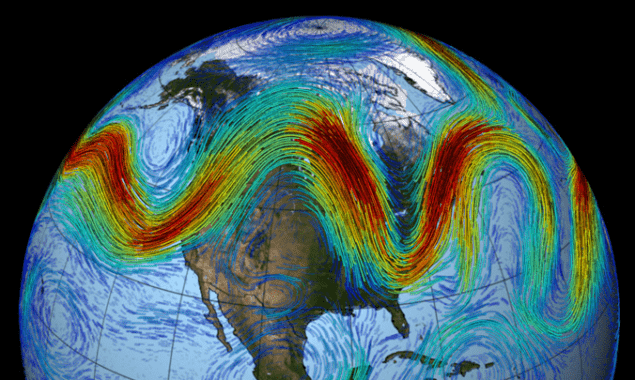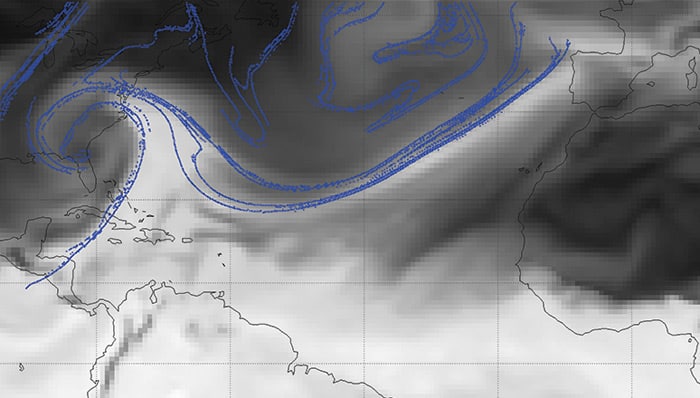
Extreme rainfall events (EREs) that occur days and thousands of kilometres apart can be synchronized, according to a study done by researchers at the Grantham Institute for Climate Change in the UK and the Potsdam Institute for Climate Impact Research in Germany. Niklas Boers and colleagues say that understanding this phenomenon could lead to better weather forecasts and more accurate climate models.
Regional weather systems such as tropical cyclones dump rain over huge areas, so it is no surprise to find correlations between EREs at the sub-continental scale. If a hurricane brings torrential rain to one location, it is very likely that a similar downpour 100 km away is related.

Cape Town ‘Day Zero’ water crisis due to migrating moisture corridor
Boers and colleagues found that correlations between EREs diminish as the distance between them increases to about 2500 km. Systems like this tend to obey a power law, with correlations diminishing as EREs become more distant from one another. This makes sense intuitively, since moving away from a weather complex will take you out of its influence and into areas governed by other systems.
Rossby waves
However, when EREs are separated by more than 2500 km, the team found that a different relationship takes over, and the likelihood of two such events being “teleconnected” starts to rise. The researchers attribute this long-range relationship to large-scale atmospheric patterns called Rossby waves.
To determine the details of these global-scale relationships, the team analysed satellite observations of rainfall collected daily between 1998 and 2016. Their data set consisted of a grid of 576,000 individual time series spanning 50° either side of the equator.
The researchers classified an ERE as any continuous period in which the daily rate of rainfall was higher than the 95th percentile value. Treating each grid cell as a node of a network, the researchers sought pairs of events that could be said to be synchronized – that is, EREs at two grid cells occurred within 10 days of each other.
“We tested different values for the maximum delay, but it became apparent that for three days, the global-scale pattern is only incompletely developed, suggesting that it takes longer than three days to establish,” Boers told Physics World. “Beyond 10 days, on the other hand, the spatial patterns do not substantially change, indicating that the right time scale for the global pattern to develop is roughly 10 days, on average.”
Data deluge
Even setting a relatively high threshold for what constitutes a correlation, searching such a large data set returned enough false positives to drown out the signal. Simply raising the threshold further was not helpful, as this removed genuine correlations. Instead, the researchers assumed that real teleconnections are geographically coherent: events in one region preferentially link to events in another, whereas the coincidental correlations making up the noise possess no such structure. When the data were filtered for this effect, a distinct spatial pattern emerged.
Taking EREs associated with the summer monsoon in south-central Asia as an illustrative case, the researchers found that synchronized events elsewhere on the planet clustered around particular locations, and were especially common in eastern Asia, tropical Africa, Europe, and eastern North America. The most likely processes connecting EREs over such distances are Rossby waves – large oscillations in the jet streams that are caused by the Coriolis effect.
Crossing the line
A surprise result from the analysis was that synchronizations appeared between EREs in south-central Asia and the mid-latitudes of the southern hemisphere. This was unexpected because weather systems do not typically cross the equator. Although Boers and his colleagues are confident that the synchronizations are statistically significant, they are unsure of the physical mechanism.

New study could help predict floods caused by atmospheric rivers
“It could be that the convective pulses in the Indian monsoon area are just so strong that the signal is transported to the southern hemisphere in the upper troposphere, but we currently don’t know for sure,” says Boers.
EREs are just one phenomenon that climate change is likely to exacerbate. Other kinds of extreme weather will also become more common and determining how they all relate to one another is an important goal.
“The 2010 Pakistan flood coincided with a heat wave in Russia, and from our understanding of underlying processes, I think it is extremely likely that coincidences like this are significant. We’ve only looked at extreme rainfall, and whether corresponding results are valid for other variables remains to be shown,” says Boers.
The study is described in Nature.



